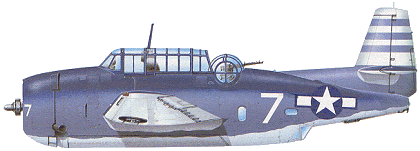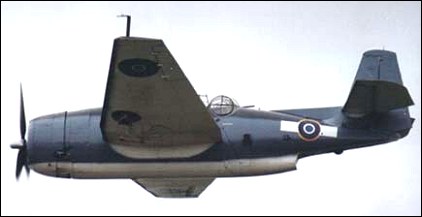|
| Standard carrier-borne torpedo aircraft and light bomber of WWII. The first prototype flew on August 1, 1941. Later models carried radar equipment for the ASW and EAW roles. A total of 9839 aircraft were built.

| MODEL | General Motors TBM-3 |
| CREW | 3 |
| ENGINE | 1 x Wright R-2600-20 Cyclone 14, 1305kW |
| WEIGHTS |
| Take-off weight | 8278 kg | 18250 lb |
| Empty weight | 4853 kg | 10699 lb |
| DIMENSIONS |
| Wingspan | 16.51 m | 54 ft 2 in |
| Length | 12.19 m | 40 ft 0 in |
| Height | 5.0 m | 16 ft 5 in |
| Wing area | 45.52 m2 | 489.97 sq ft |
| PERFORMANCE |
| Max. speed | 430 km/h | 267 mph |
| Cruise speed | 237 km/h | 147 mph |
| Ceiling | 7130 m | 23400 ft |
| Range | 1819 km | 1130 miles |
| ARMAMENT | 3 x 12.7mm machine-guns, 1 x 7.62mm machine-guns, 907kg of weapons |
| gordon, e-mail, 25.09.2022 23:56 does anyone have information on the markings of a TBF-1 on CV-7? reply | | Karl Hamilton, e-mail, 11.09.2017 17:23 We have Marine Corps TBM 85 in Culpeper Va at CAF. Hanger is open 2nd Saturday every month. New paint and had to put a Bikini on Gayle Ann but it is in flying conditon. Need bomb racks and bombs for it. Going to Dallas Tx for Wings over Dallas Oct 6-8. The exhaust is a bear to R&R. Pilots say you have to be on your toes when tailwheel is on ground or it can get away. Good AC. Like a Cub,it's so slow it can barely kill you. reply | | Jay Purdy, e-mail, 29.05.2016 04:57 My uncle and godfather, Lt. Medard Purdy, was piloting a "single engine torpedo plane" (according to newspaper account) that crashed on December 17, 1952 at Brown Field, California while practicing carrier landings. I've searched the internet exhaustively, but can find no further information about the accident. Any suggestions? reply | | Frank Douglass AOM2/c, e-mail, 05.06.2015 07:06 Was the turret gunner on the TBF /M off the CVE 76 Kadashan Bay in VC 20 Squadron in 1945 following the Leyte Gulf battle and then in the Manila, Luzon invasion, we took a kamakazie and listing badly,our TBF's and F4F's were sent to other carriers as we left the battle for repairs. Both airplanes were excellent fighters. reply | |
| | Merton A. Bobo, e-mail, 17.03.2015 00:27 This airplane was the "workhorse" of the Navy in WWII. I I I was an aviation radioman /aircrewman in WW II and flew missions in the Pacific; Philippines, Iwo Jima and Okinawa. This airplane was incredible with armament in wings, 50 caliber turret, 30 caliber in the radio compartment, 2000 lb. bomb load in the bomb bay and (4) 5" rockets under each wing. Give much credit to this airplane for the retaking of islands from the Japanese in WWII. We supported the landings by Army and Marines. I am thankful for my experiences and thankful for many "near-sighted" Japanese anti-aircraft gunners as well. Grumman built great airplanes. reply | | Dr Richard Dexter Olson, e-mail, 04.02.2015 22:55 I flew the airplane [ours were TBMs] for Advanced Flight Training at NAS Kingsville TX from Sept `54-Feb `55; GREAT airplane, my instructor was LT George Willey; flight mates were Dan Barker, & Dick Ellis; would love to hear from anyone who was there at the same time. reply | | Ron Ely, e-mail, 30.01.2015 09:49 My dad, Dale R. Ely, served as a yeoman aboard the U.S.S. CHENANGO, CVE-28 during WWII, '42-45. They were involved in numerous South Pacific battles, and even transported several loads of POW's out of Tokoyo when the war ended.
Dad was aboard until they sailed back down and through the Panama Canal, up the East coast to put the ship out of commission in Boston harbor.
They had SBD's, F4F's (later traded in for F6F's) and TBM's.
We took him to a 40's Warbirds Air Show in Chino, CA years ago before he died, and I'll never forget the look on his face when they fired those planes up to fly 'em! Especially the F6F, F4U and the TBM. There IS no other sound quite like one of those radial engines starting. reply | | Tom Gillespie, e-mail, 17.01.2015 22:03 I was a aircraft radio technician 1st class and assigned to Stag One. We used the Avenger as control aircraft for drones in South Pacific during WWII.. Quite a aircraft. reply | | Joe Hempsey, e-mail, 06.04.2014 23:03 My dad was a navy photographer /machine gunner in the Grumman TBF, South Pacific, Japan, Guam; amazing time, amazing stories and of course God bless the amazing men who literally saved the world. reply | | john, e-mail, 22.03.2014 21:14 My uncle Lt jg lenord j Mason flew the TBMs off the USS Bunker Hill he was KIA anyone left that may of known him please let me know thanks reply | | Willis E. Vanderberg, e-mail, 20.01.2014 23:28 I was aboard the carrier USS Salerno Bay CVE 110, from 51 to 53. We flew many TBM'S of her deck.We used both deck launch and catapult. We had two catapults the H-2 And H-4. The H-2 left a little to be desired but the H-4 was ok.
It was quite an experience to put the plane on the deck at night in the north alantic, in mid winter with seas runnig high. It took a good LSO and pilot in a combined effort to accomplish the landing. I can only recall two fatalities in that period. Great rugged old bird reply | | Leroy McVay, e-mail, 06.01.2014 20:58 Lets not forget General Motors made lots of these, designator TBM. Worked on them as full time reserve at Sand Point Naval Air Station, Seattle. Around 1955 they took the TBMs away and gave us AFs. Asked for our TBMs back. Later, around 1956, got S2F Gruman Gardians. BEGGED for our TBM back. reply | | maryann, e-mail, 06.06.2012 02:40 anyone on this website know my uncle steven (TIPPY) turawski? his whole plane went missing over the triangle avenger bomber off of uss mindoro mid to late 40's. reply | | Magnum78, 05.05.2012 04:11 A real classic WWII aircraft. With aircraft like that, I understand why Grumman earned the nickname "the smithy". reply | |
| | Mike, e-mail, 03.05.2012 18:42 My Dad, who passed away last year, was a AMM2 on board the USS Wasp (CV-18). He was Turret Gunner and absolutely had a love affair with the TBF /M! I took him to many WWII Weekend airshows in Reading, Pa. where he got to see a number of restored Avengers and even climbed up into the turret one year in full flight gear. . .he loved it!! reply | | Joseph Brown, e-mail, 12.03.2012 19:35 I spent the most part of eight years in on of these old birds .I was in A.S.W 792as A radar man we had two crew men in the back. I thought it was great for what we were doing.
JOSEPH BROWN ,GEORGIA. reply | | Grady Jensen, e-mail, 07.02.2012 14:57 I went through operational training at NAS Fort Lauderdale, FL in 1945 and qualified in carrier landings in the TBF /TBM aboard the USS Wolverine, on Lake Michigan - out of NAS Glenview. Great airplane! Safe as an old rocking chair. reply | | William H. Lyles, e-mail, 05.02.2012 22:09 The TBM's were a great plane and one of the safest to ever operate from an Aircraft Carrier because of their slow stall speed around 65 knots. I was a member of VS-892 /VS-38 from 1951 to 1954. In 1953 we (VS-38) were the last squadron to deploy with TBM's during the Korean War. The Navy retired the old Turkey Birds and switched the the the new twin engine S2F's another great plane. reply | | RON LEWIS, e-mail, 13.09.2011 23:52 For Peterbess: If you are talking of the upright, angled fitting on top of the port wingtip, that's the pitot tube. reply | | Alvin :Bud Baron, e-mail, 16.08.2011 17:23 I was an aviation electronicsman 3rd class in VS 26 an anti-submarine squadron. In 1950-51, the plane was modified with the removal of the turret and addition of anti-submarine gear. The center canopy area behind the pilot had a radarman position added. The turret area had receivers for sonobuoys which were dropped in the water near suspected submarine sights. The belly which previously were quarters for the radioman housed a searchlight operator. The plane was designated a TBM 3N. This aircraft was the killer part of a hunter killer team. The hunter was equipped with a large belly radome and flew with a pilot and two radar operators squeezed into the back. Working with an American sub 100 miles off NOrfolk VA at midnight we had an engine failure at 300 feet. We lost the searchlight operator and could not get the raft out because the hatch was painted dark blue. The plane sank in seconds leaving me and the pilot with his one man raft. Six weeks later, flying off the USS Mindoro in Operation Lantflex a war game, around midnight, the hunter vectored us toward a suspected sub 440 miles SE of Bermuda. We located the sub which dove as we approached. We dropped several sonobuoys around the sub's last position. I heard the sub's propeller cavitation on my radios and vectored the pilot to drop more sonobuoys. I had very strong signals of the sub's prop, vectored the pilot around to drop a dummy depth charge on it. With the bomb bay doors opened and making these drops at 300 feet altitude in the dark, we accidentally flew into the sea. The force of the crash flew the raft out of its hatch. The pilot, the radarman, and I got out, but the searchlight operator who was just behind the open bomb bay window never made it out. The three of us hung on to the pilot's one man raft. Fortunately, we were picked up by the USS Harwood, a DE, several hours later. reply |
|
Do you have any comments?
|
| 
COMPANY
PROFILE
All the World's Rotorcraft
|







